Always attack. Even in defense, attack. The attacking arm possesses the initiative and thus commands the action. To attack makes men brave; to defend makes them timorous.
Steven Pressfield, The Virtues of War
Does America even know where is it heading? Fictitiously yes. Geopolitically no. So it does not admit the fact that it lost the war, the region, and the moral compass on civility. And nothing captures this more than the odd official military practice that reversed the American flag itself.
Following the 9/11 attacks, the US embarked on a new worldwide mission: A Global War on Terror. As the usual storyline goes, the aim was to hunt down bin Laden, topple dictators, and scorch Earth to prevent it from being a breeding ground for terrorists. Today, it sounds like a hackneyed wording with a worn-out and lofty goal. Even talking about it makes people feel jaded and disillusioned. Yet two decades ago, the world hastily plunged into this war. Bush initiated, Obama enshrined, Trump dithered, and Biden seems to be ending it: “It’s time to end this forever war”.
However, the US had been trying to end it since the onset. Despite the initial self-congratulatory remarks and billions of dollars, the war had already become ruthlessly violent and unbearably pointless, aimless and endless. Especially in the Afghan theatre, a meaningful exit sign had never been on sight. As recently expressed by Gorbachev, “like many other similar projects, at [this war`s] heart [were] the exaggeration of a threat and poorly defined geopolitical idea”.
Fittingly, during the course of the war, the US used another flag to hoist and another one to fight. This regulation initially had a martial meaning to hearten the troops abroad. Gradually, as an insulating logic, it allowed the US to save its face from its wrongdoings. Yet eventually, it eerily diffused into every section of American culture and society and caused a disorientation problem as a discourse: a diffused mentality replete and obsessed with “attacking” to win. In what follows, I will do a brief foray into how this flag practice manifests the very ways the US looks at itself and the world, contributing to losing its direction in an uncivil fiction of its own making.
2
The Reversion of the Flag
Have you noticed another fittingly ignored yet widely familiar spatial confusion on flag layouts lately? Are the US flags look facing forward or backwards these days? Or do you ever feel like you are looking at it from a wrong angle? In 2003, the US Army updated its uniform regulation and visually embraced the “Assaulting Forward” maxim. Accordingly, combat troops had to use reversed US flag patches on their right shoulders to give the visual effect that the US forces are always advancing and always in charge. This practice might be confusing as any variation of a flag flown in a different configuration than the standard use is usually viewed as a sign of distress, disrespect, or protest. But such is not the case.
As the body is deemed to function as a flag pole upon which the flag is attached, the wearer had to give the impression as though the US flag is flying in the breeze in each step. Or else, if the stripes are facing forward, God forbid, it might give the undesirable impression to the onlookers that the US soldier is retreating. However, regardless of the direction, if the stars are facing forward, as the US should always seem to be moving onward and assaulting headlong, everything is fine. Thereby, the posture and standing of the US military are visually maintained. Star constellations on the uniform can direct the soldiers to new American frontiers to break through as predestined. After all, the location of the manifest destiny is not at a fixed point. Once reversed, obverse stars become the beguiling guide for the US war machine, fit for the occasion.
Although using reversed flag patches had earlier precedents, it became official with this regulation in 2003, and other branches of the US military quickly followed suit. Oddly enough, not only the deployed combat troops but almost all military personnel lured by the reversed design began to use these patches to secure a striking flag impression.
But as the “assaulting forward” and “taking the fight to the enemy” logic further crept into the society during the ever-globalising War on Terror years, the reversed flag practice steadily gained widespread traction: the police, a myriad of law enforcement officers and even civil society. Embraced by many, reversed flags were now banal and omnipresent. While forward-facing stars were defining the direction and the course of action, the so-called isolated realms of “the international” with those of the domestic jarringly collapsed into each other. This fake dramatism, rather than securing, caused motion sickness and confusion between the inside and the outside, the front and the rear, the battlefront and the homefront. For instance, why should a flag be assaulting forward on a city bus while carrying commuting people in an urban setting? To remind people that this is the new normal, or is everything upside down?
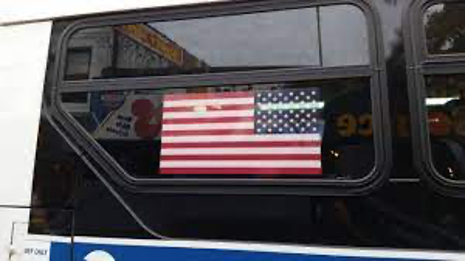
Figure 1 The flags on the side windows of NYC MTA buses are pointing the wrong way.
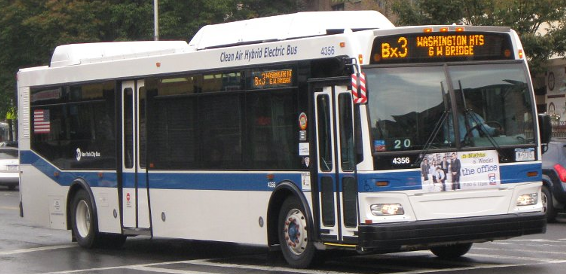
Figure 2 Another NYC Bus with a reversed flag
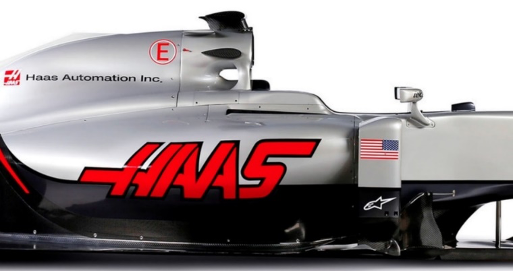

Figure 4 American Flag on the right-hand side of the Space Shuttle Endeavor.
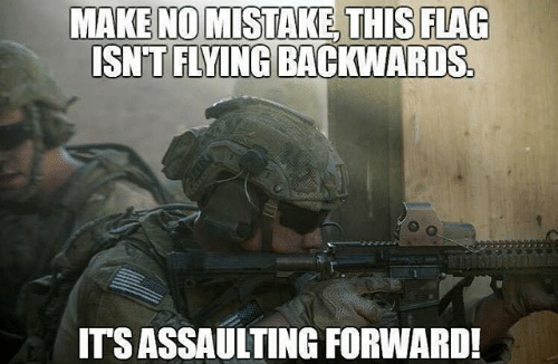
Figure 5 An internet meme on the military meaning of the reversed flag.
As the mobile flag posts fixed on right arms spanned the globe, the confusion surrounding the central tenets of US identity deepened. Who were the Americans? All to make America look powerful and charging, the banality of reversed flags was chasing anyone, anytime, anywhere, to fix the American identity. “Lest we forget”, they were patched and hanged everywhere, reminding the US is at war. And regardless of the location, front-facing stars was to guide the way as a compass towards manifest destiny. “Assault forward to win, wherever, however”. Still, the complex problems were enduring. Was America winning or losing in Iraq and Afghanistan? Striking or retreating? Who and where was the enemy? How and where could they be revealed? Which way should be used?
3
The Inversion of the Flag
Flags have always been important in world politics. They allow you to mark and expand your territory, prompt people to rally around and are helpful to brag about yourself. Besides, they are not only visual markers. They embody a banal discourse keeping it raging throughout the social. You can imbue them with all the symbolism of a moral high ground you think you bear by simply being a member of an imagined community. Heeded, apart from loaded symbolism, the US is one of the few countries with a strictly regulated flag code. From hoisting it horizontally and vertically to folding and unfolding it ceremonially, the US Flag Code guides every step of the flag usage. The reason behind it is to fix the national symbolism therein and to prevent it from changing. However, not the hoisted one but the reversed one donned on uniforms seems to manifest the confusion and disorientation the US incurred itself. Further, its overuse is gradually risking a misperception of the original flag.
On the one hand, to pass the naturalization test for US citizenship, it is mandatory to know your country`s flag correctly. Thus, it should be strange to be in a cultural context to confuse the standard outlook of a national flag for a citizen. For instance, some Reddit and Imgur users fell prey to this confusion and questioned why the Police Chief from Stranger Things, Jim Hoppers’s flag patch is always backwards. However, stranger than fiction, Hopper`s flag patch bears the traditional look in every episode. As another Reddit user ripostes, in the ’80s, there was no such regulation. Flags were adorning uniforms in the same way they are hoisted on the poles.
On the other hand, this short perplexion manifests a symbolic but equally real problem about being unable to recognize yourself, your ideals, and your symbolism. As the US military stretched itself too thin while “assaulting forward” anywhere on Earth, the society it defends is estranged from its own flag at home. Put differently, people might not simply confuse the rights and wrongs of the US flag out of their ignorance but do so from the seemingly innocuous visual reasoning the US steered itself during the last two decades. That reasoning is premised on a false dilemma as though “assaulting forward” refers to “winning” and “winning” worths everything.
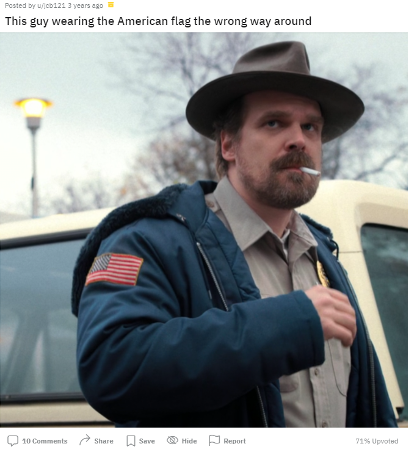
Figure 6 “This guy wearing the American flag the wrong way around”
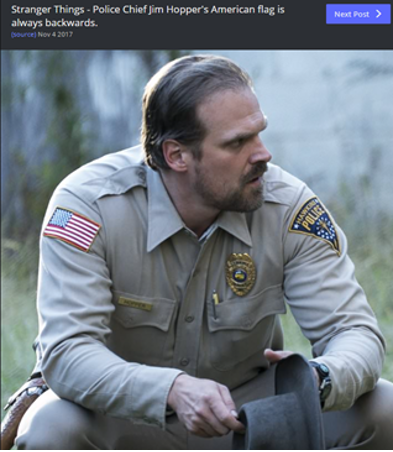
Figure 7 “Stranger Things – Police Chief Jim Hopper’s American flag is always backwards.”
In this sense, the infusion of the visual motto of “assaulting forward” into the mundane moments of everyday life is troubling. Why would people “assault forward” in their homeland settings as though they are running into battle? When the spatial settings and the fixed positions are replaced with visual impressions, the common ground we think and act on fades away. Disorientation ensues. Default defense mechanisms take over. After that, even the most domestic civilian settings might turn into a battleground. As we repeatedly saw during the last years, the police forces are over militarized and overused as a nostrum for every domestic case in the US. And in every case, the police further exacerbated the situation racially and lethally. It gets harder to tell the good ones from the bad ones, the military from the police, and even the regular flags from the reversed ones in such a setting.
Moreover, apart from their military gears and reversed flag patches reserved for deployed combat troops, the US police departments now have their own reversed flag patches. Initially designed as a tribute to the first responders of 9/11, today, the Thin Blue Line flag is often used as an aide-mémoire for the police forces` necessary positioning between order and anarchy. The blue stripe in the middle refers to the police forces as the line which keeps society from descending into chaos, as though half the US and the flag is in disorder. Resulting misorientation in an upside-down world further heartens vigilantes -be it official or civilian- to open fire for whatever target and cause they see fit.
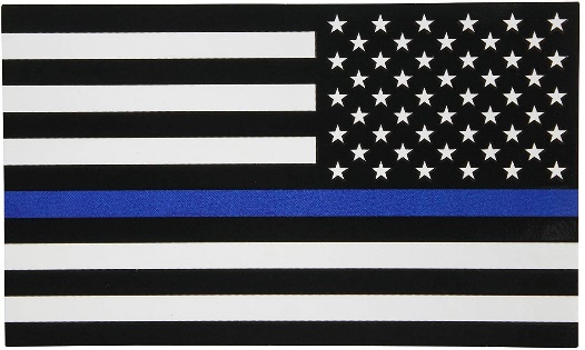
Figure 8 The Thin Blue Line Flag
Correspondingly, Trump supporters storming Capitol Hill in early 2021 generated a suspicion between the rioters, agents and soldiers. As the rioters abused more than tens of different flags and scenarios to fix the already unsettled positioning of the US and the course of the elections in the Capitol, the question of who let them in or did not stop them is emblematic of a confused and directionless America as well. Nobody knows who represents whom. Nobody trusts who serves whom. In such a logic, anyone can be targeted as a foe. The US police officer Michael Fanone`s experience while defending the Capitol from Pro-Trump rioters is telling. Further illustrative of this, soon, America’s domestic settings were to be confused with America’s warzones abroad and even its celebrated Special Forces with reversed flags to be deployed against their very own populations to defend the White House. The inversion of everyday domestic arrangements hence became so usual.
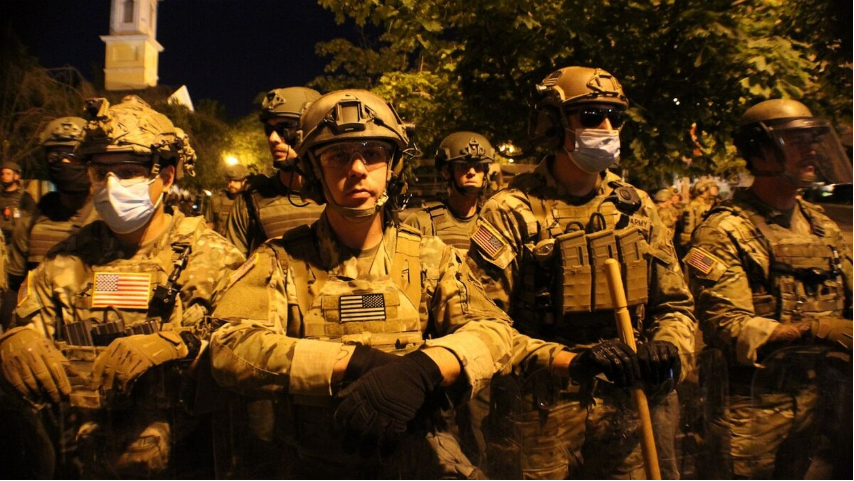
In short, following Bush, a black, an orange and a white president consecutively represented the US. Each came with their seemingly new solutions to the US` role and path in world politics. Each hailed as a new saviour. Each saluted the same flag. Yet each sent troops abroad with reversed and subdued ones, different from the ones they saluted. They made them don what they did not hoist. They made them do what they seemingly do not want to do. And today, we see another American retreat under the guise of ending war and peacefully returning soldiers home.
More importantly, the reason why the President is so unconcerned and thinks that he did the right thing by pulling the troops out of Afghanistan in such a self-assuringly careless and reckless way derives from the fact that he is at the helm of a disoriented discourse within which wherever America may roam, its course of action is always in the right direction. After all, he does not care about the location. He cares about the situation and maintaining the fiction through false dilemmas between defeat and withdrawal to the detriment of people. Thus he is unfazed by the prospects of unjustly ending an unjust war.
Still, is it a retreat? An end? Wishful thinking it is. The issues are not that clear-cut. Even though Biden is eager to shrug off and talk about happy things, those issues are bleeding into broader society. America`s global problems and vice versa are not simply about a few bad apples. Nor are they simply caused by structural issues. Instead, a deeply embedded social logic is empowering the US to interpret the world through false dilemmas. As Giroux put it, after “September 11, American power [was] restructured domestically around a growing culture of fear and a rapidly increasing militarisation of public space and culture”. Heavily relying on pushing forward through superior firepower for superior gains, this assaulting mental state adopted to cope with fear, today, deeply diffused in the self-adorned icons of the US and sacrificed them. Hence, no matter whether the US is retreating, the Global War on Terror did not end. The war left the world and the US in a pointless, endless, and aimless state, its flag forward a metaphor for its discombobulated state.


0 Comments